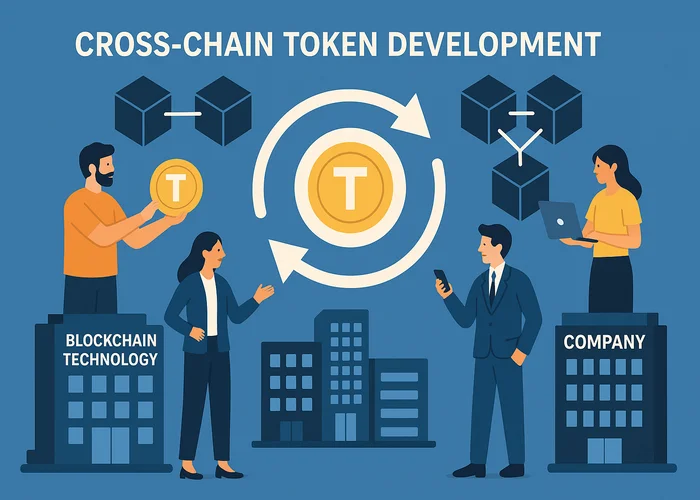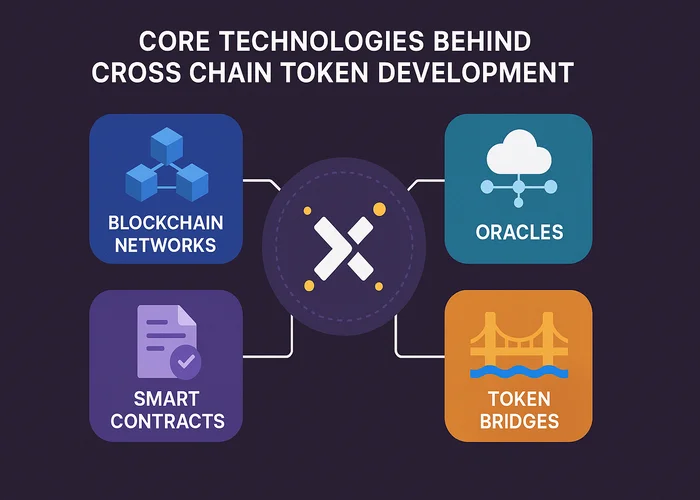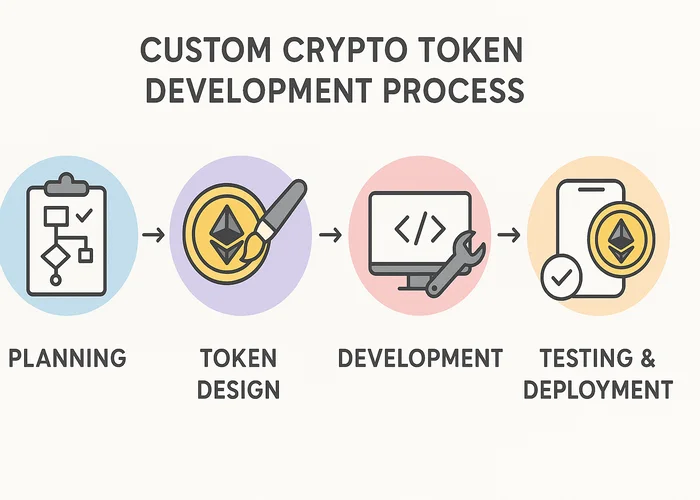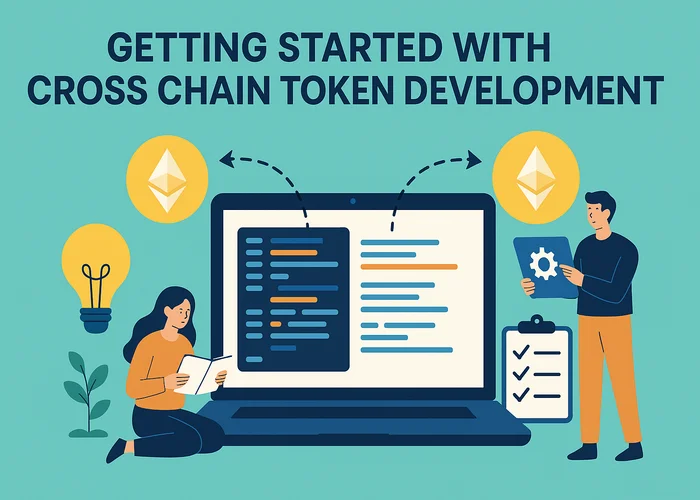Understanding Cross Chain Token Development
Cross chain token development is a cutting-edge method for developing digital assets that work across blockchain networks. Cross-chain tokens use advanced blockchain interoperability technologies to flow freely between networks, keeping their value and usefulness regardless of the underlying infrastructure.
This novel technique solves one of the biggest blockchain ecosystem issues: network isolation. Traditional blockchain networks are silos with their own protocols, consensus methods, and tokens. Cross-chain technology unites various networks, allowing assets to flow freely.
Cross-chain token development is crucial in today’s fragmented blockchain world. Ethereum, Binance Smart Chain, Polygon, Solana, Avalanche, and other networks each have their own benefits, thus consumers and developers require solutions that combine them.
The Evolution of Multi-Chain Token Development
Traditional Single-Chain Limitations
Before multi-chain token development, businesses and developers had to choose one blockchain network. This choice frequently involves major trade-offs:
- Ethereum has high gas fees and scalability issues, but its security was strong.
- Performance vs. Decentralization Newer chains were quicker but less decentralized.
- Ecosystem Lock-in: Projects placed on a chain were bound to its limits and user base.
These limits created a fragmented economy where valuable projects were isolated on their selected networks, unable to benefit from other blockchain platforms’ advantages.
The Multi-Chain Revolution
Blockchain interoperability solutions have transformed this paradigm. Modern cross-chain token development lets projects:
- Tokenize many networks simultaneously.
- Take advantage of blockchain platforms’ strengths.
- Reach diverse user and liquidity pools
- Introducing advanced DeFi cross-chain solutions for future-proofing applications against network fluctuations.
Core Technologies Behind Cross Chain Token Development
Bridge Protocols
Bridge protocols underpin most cross-chain token implementations. These advanced methods allow tokens to flow between blockchain networks without losing value. Several bridge protocols exist:
Lock and Mint Bridges:
The source chain locks the token, and the destination chain mints an identical amount. This method maintains entire supply across all networks.
Burn and Mint Bridges:
Burning tokens on the source chain and minting them on the destination chain maintains supply consistency across networks.
Atomic Swaps:
These allow peer-to-peer token trades between blockchains without middlemen, but only on chains with compatible scripting.
Cross-Chain Communication Protocols
Modern cross chain token development uses advanced communication protocols to securely exchange data between blockchain networks. The protocols handle:
- Transaction verification across consensus mechanisms
- Token transfer coordination between networks
- Multiple chain state consistency
- Security guarantees for cross-chain operations
Interoperability Standards
Benefits of Cross Chain Token Development
Enhanced Liquidity Access
One of the biggest benefits of cross chain token development is liquidity across many networks. Single-chain coin liquidity is constrained by their native network. Cross-chain tokens can access all supported networks’ liquidity, resulting in:
- A better pricing discovery system
- Lower slippage for large transactions
- Increased DEX/AMM trading opportunities
- More market depth and stability
Risk Diversification
By distributing token deployment across different networks, multi-chain token development diversifies risk. This method provides numerous protections:
- Reduced single-chain risks including network attacks and governance breakdowns
- Protection against network-specific regulatory issues
- Individual blockchain implementation technical risk mitigation
- Increased ecosystem resilience to market volatility
Expanded User Base
Cross-chain tokens can reach users on all supported networks, thereby boosting their user base. This expanded reach means:
- Adoption opportunities rise
- More users accessing the token increases network effects.
- Increased brand awareness throughout blockchain communities
- Better token usage and velocity
Optimizing Cost
Different blockchain networks charge different transaction fees. Users can choose the most cost-effective network for their use case via cross-chain tokens.
- Complex, expensive transactions on secure networks
- Microtransactions on cheap, fast networks
- Multifaceted smart contract interactions on feature-rich platforms
- Easy transfers on optimized payment networks
Leading Blockchain Technology Companies in Cross Chain Development
Specialized Cross-Chain Development Firms
Exclusive cross-chain development companies have emerged to meet the growing need for blockchain interoperability solutions. Services offered by blockchain app development companies include:
- Design and execution of cross-chain architecture
- Developer and security auditor of bridge protocol
- Crypto token custom development with multi-chain capabilities
- Compatible with tokenization platforms
- Regular maintenance and upgrades
Enterprise-Grade Development Companies
Major crypto token developers now provide enterprise-grade cross-chain solutions for large projects and institutions. These companies usually offer:
- Complete project management for complex cross-chain implementations
- Multi-jurisdictional regulatory compliance consultancy
- Scalable infrastructure for high-volume cross-chain activities
- Custom blockchain ecosystem creation for corporate needs
Emerging Technology Providers
Innovative cross-chain solution providers have potential as blockchain technology evolves rapidly. The suppliers focus on:
- New cross-chain security consensus techniques
- Innovative cryptography for interoperability
- AI-optimized cross-chain routing and fees
- Integration with quantum-resistant cryptography
Technical Architecture of Cross Chain Tokens
Standard Token Compatibility
Successful cross-chain token development needs thorough token standard consideration across networks. Modern cross-chain tokens must support:
- ERC-20 and EVM-compatible chains on Ethereum
- On Binance Smart Chain
- SPL tokens on Solana
- TRC-20 on TRON
- Native tokens on Cosmos-based networks.
This interoperability enables tokens use each network’s infrastructure, wallets, and services.
Smart Contract Architecture
- Cross-chain token smart contract architecture includes several critical components:
- The core token contracts on each supported network implement the basic token functionality, ensuring uniform behavior regardless of the blockchain.
- Bridge Contracts facilitate token transfers between networks, including validity, minting, burning, and security checks.
- Governance Contracts: These oversee all supported networks’ upgrades, parameter modifications, and governance functions.
Oracle Integration: Oracle networks provide trustworthy data feeds for many cross-chain systems.
Security Considerations
- Cross-chain token smart contract architecture includes several critical components:
- The core token contracts on each supported network implement the basic token functionality, ensuring uniform behavior regardless of the blockchain.
- Bridge Contracts facilitate token transfers between networks, including validity, minting, burning, and security checks.
- Governance Contracts: These oversee all supported networks’ upgrades, parameter modifications, and governance functions.
Oracle Integration: Oracle networks provide trustworthy data feeds for many cross-chain systems.
DeFi Cross-Chain Solutions and Use Cases
Decentralized Exchanges (DEXs)
DeFi cross-chain solutions allow DEXs to aggregate liquidity across various networks, revolutionizing decentralized trading. Cross-chain tokens are vital to this ecosystem because:
- Offering consistent trading pairs across networks
- Creating chain arbitrage opportunities
- Making cross-chain yield farming easier
- Enhancing trading with cross-chain limit orders
Lending and Borrowing Protocols
Cross-chain lending protocols improve capital markets with multi-chain tokens. Users can:
- Select ideal networks to deposit collateral and borrow, resulting in improved interest rates.
- Spread loan risk across blockchain platforms.
- Take part in cross-chain liquidation
Yield Farming and Staking
Multiple-chain token development allows advanced yield farming tactics that weren’t available before:
- Cross-chain staking pools combine network rewards
- Dynamic yield optimization that automatically targets high-yield possibilities
- Cross-chain governance tokens with protocols-wide voting rights
- Complex multi-network reward distribution mechanisms
Custom Crypto Token Development Process
Planning and Strategy Phase of custom crypto token development process
Custom cross-chain crypto coin development starts with thorough planning:
Network Selection:
- Based on target audience, technological needs, and strategic goals, selecting the best blockchain networks.
- Tokenomics Design: Building economically efficient models with consistent value propositions across many networks.
Definition of Use Case:
- Define how the token will work across networks and its unique value.
- Development and Execution
- The technological execution of cross-chain tokens requires several crucial steps:
- Smart Contract Development: Building secure, reliable smart contracts for each target network.
Bridge Integration:
- Integrating bridge protocols for cross-chain transfers.
- All target networks are tested, including security assessments by professional firms.
- Oracles, monitoring systems, and user interfaces are deployed during infrastructure setup.
Launch/Deploy
- Several networks must coordinate during launch:
- Staged deployment: Gradual rollout across networks to identify and fix issues before complete deployment.
- Setting up initial liquidity pools and trading pairs across all supported networks.
Community Education: Teaching people how to use the token across networks.
Tokenization Platforms and Infrastructure
Comprehensive Development Platforms
Modern tokenization platforms offer cross-chain token development by default. These platforms provide:
- Visual tools for cross-chain token logic design
- Common cross-chain modules pre-built
- Multi-network automated deployment tools
- Integration testing environments for cross-chain operations
Infrastructure-as-a-Service Providers
Blockchain-focused cloud-based infrastructure vendors now provide extensive cross-chain token deployment solutions.
- Managed multi-network node infrastructure
- Monitor and analyze cross-chain data
- Backup and recovery automation
- Scalable cross-chain APIs
Integration of Third-Party Services
Let’s see How to Create Your Own Cryptocurrency Token and also many successful cross-chain tokens interface with third-party services:
- Cross-chain wallets for user convenience
- Analytics solutions that track token performance across networks
- Multi-jurisdictional regulatory compliance tools
- Token marketing platforms for several blockchain ecosystems
Blockchain Ecosystem Development Strategies
Community Building Across Networks
- Building communities across blockchain networks is necessary for cross-chain token ecosystem development:
- Network-Specific interaction: Tailoring community interaction to blockchain network culture and preferences.
- Events that bring users from different networks together around common interests are called cross-chain events.
- Educational Content: Developing cross-chain functionality education resources.
Partnership and Integration Strategies
- Build Your Own Cryptocurrency Token with these stratergies
- A thriving cross-chain token ecosystem requires strategic partnerships.
- Integration with DeFi protocols, DEXs, and other services across networks.
- Collaborating with other cross-chain efforts to generate synergistic ecosystems.
- Enterprise Partnerships: Working with cross-chain token-using companies.
Governance and Decision Making
- Multiple network governance brings various challenges:
- Implementing governance systems that aggregate votes across networks – multi-chain voting.
- Treating proposals that affect specific networks differently.
- Implementing governance choices consistently across all supported networks involves coordination mechanisms.
Future Trends in Cross Chain Token Development
New Technologies
- Several new technologies will shape cross-chain token development:
- Zero-Knowledge Proofs: Advanced cryptography for private and efficient cross-chain operations.
- Integration of layer 2 solutions over base layer networks for scalability.
- AI-Powered Optimization: Optimizing cross-chain routing, fees, and user experience.
Regulatory Change
- The cross-chain token regulatory landscape is changing rapidly:
- Multi-jurisdiction Compliance: New frameworks for regulatory compliance across jurisdictions.
- Create international cross-chain token standards.
- RegTech: Automated compliance monitoring across numerous networks.
Market Integration
- Cross-chain coins are integrating with established financial markets:
- Institutional Investor Interest: Cross-chain token schemes are gaining popularity.
- Integration of cross-chain tokens with standard financial instruments.
- CBDCs: Cross-chain tokens and government-issued digital currencies may integrate.
Getting Started with Cross Chain Token Development
Assessment and Planning
- Start cross chain token development with a thorough assessment:
- Technical Needs Analysis: Understanding your use case’s technological requirements.
- Market Research: Comparing blockchain networks’ target markets.
- Resource Planning: Assessing development resources and expertise needed for implementation.
Choosing Development Partners
- Success requires choosing the correct crypto token development company:
- Technical expertise: Ensuring the development staff has cross-chain experience.
- Networking: Selecting partners with strong blockchain ecosystem links.
- Supporting maintenance, upgrades, and ecosystem development after launch.
Implementation Strategy
- Planning is essential for cross-chain token ventures.
- A gradual rollout allows learning and optimization.
- Engagement: Building target network communities before and during launch.
- Continuous innovation: Planning for feature enhancement and development.
Conclusion
Cross-chain token creation is the future of blockchain technology, allowing projects to leverage the multi-chain ecosystem. Innovative cross-chain token deployments will increase as blockchain interoperability solutions evolve.
From standard bitcoin token development to complex cross-chain solutions involves planning, technical competence, and strategic thinking. businesses who embrace this transformation and partner with professional blockchain app development businesses will profit from cross-chain tokens’ increased liquidity, decreased risk, and expanded prospects.
Understanding the technology, picking the correct development partners, and having a long-term ecosystem growth vision are essential to creating your first cryptocurrency token development or one with extensive cross-chain capabilities. Multi-chain blockchain is the future, and cross-chain token creation will link this diverse and powerful ecosystem.
Build the Robust Cryptocurrency with Cross chain token development company. Lets Connect together.
FAQs
1. What is the difference between cross-chain tokens and traditional single-chain tokens?
Single-chain tokens are limited to one blockchain, but cross-chain tokens work fluidly across many blockchains. The main differences:
- Functionality: Cross-chain coins can transfer between Ethereum, Binance Smart Chain, and Polygon without losing value. Native blockchains lock single-chain tokens.
- Cross-chain coins can access liquidity pools across several networks, improving trading opportunities and reducing slippage. Traditional tokens’ liquidity is network-specific.
- Technical Complexity: Cross-chain tokens require complex bridge protocols and interoperability solutions, making them harder to build but more flexible.
- Risk Profile: Single-chain tokens are risky due to their host blockchain’s performance and security, while cross-chain tokens are naturally diversified.
- User Reach: Cross-chain tokens can reach users on all supported networks, thereby boosting their user base.
2. How much does it typically cost to develop a cross-chain token?
Cross chain token development costs vary greatly depending on numerous factors:
Basic Cross-Chain Token: $50,000–$150,000
- Easy bridge connectivity with 2-3 large networks
- Normal token functionality
- Basic security checks
- Limited customization
The Advanced Cross-Chain Solution: $150,000–$500,000
- Designing custom bridges
- Integration with 5+ networks
- Features like yield farming compatibility
- Complete security checks
- Custom tokenomics and governance
Enterprise Platform: $500,000–$2,000,000+
- Fully customized cross-chain infrastructure
- Integration with 10+ networks
- DeFi advanced features
- Multi-security audits
- Support and upkeep
Possible Extra Costs:
- Each network implementation costs $5,000–$50,000.
- Security audits ($25,000–$100,000)
- Legal and compliance consultation ($20,000–$100,000)
- Marketing, community building ($50,000–$500,000)
3. What are the key technical requirements for implementing cross-chain token functionality?
- Smart contracts with consistent functionality on each target network
- Network token transfer bridge protocols (lock/mint or burn/mint).
- Verifying cross-chain data using Oracle
- Security using multi-signature wallets and time-locked transactions
- Real-time monitoring of all supported networks
- APIs for smooth UI integration
4. How do cross-chain tokens handle regulatory compliance across different jurisdictions?
- Implement modular compliance features that can be enabled per jurisdiction
- Deploy KYC/AML systems across all supported networks
- Maintain detailed audit trails for regulatory reporting
- Establish legal entities in key jurisdictions for regulatory clarity
5. How can businesses integrate cross-chain tokens into their existing systems?
- APIs: RESTful APIs, WebSocket connections, and GraphQL endpoints for real-time data
- Payment Systems: Integration with crypto payment processors supporting multiple chains
- ERP Integration: Connect tokens to inventory management, CRM, and financial reporting systems
- Custom SDKs: Develop software development kits for easier implementation
6. What future developments should businesses expect in cross-chain token technology?
- Zero-knowledge bridges for enhanced privacy and efficiency
- AI-powered routing optimization for reduced fees
- Unified interfaces for managing tokens across multiple networks
- Intent-based architectures simplifying user experience






